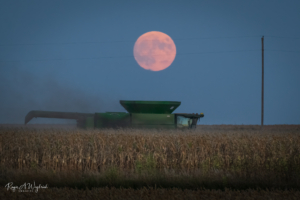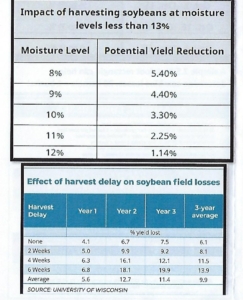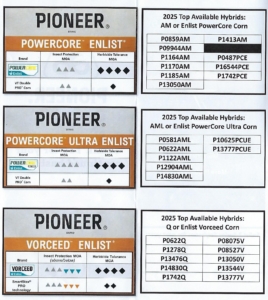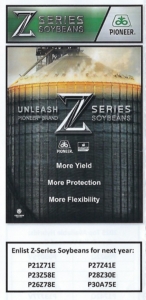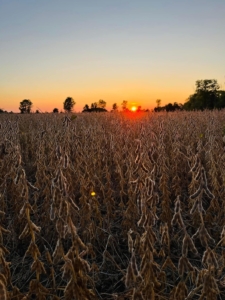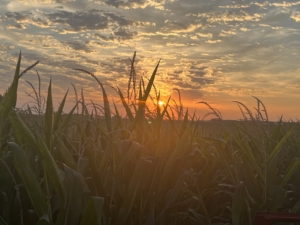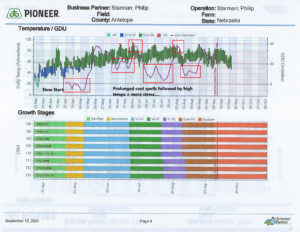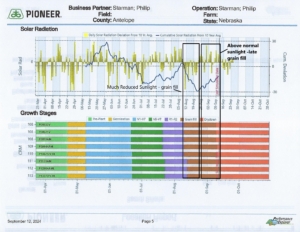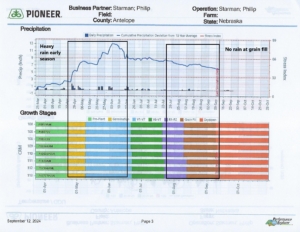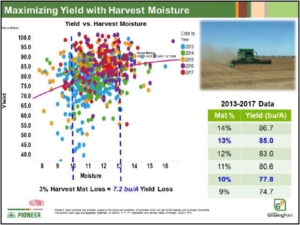
Topics:
- Growing Degree Unit Update/Weather Forecast
- Corn/Soybean Update
- Prioritizing Harvest….
- New Corn Hybrids and Soybean Series for 2025…
TEMPERATURES & GDU ACCUMULATION:
As of September 9th, we have accumulated approximately the following for Growing Degree Units in 2024:
Planting Date GDD’s2024 Average GDD Departure from average
April 23 2464 2471 -7 (even)
May 4 2381 2378 + 3 (even)
May 14 2294 2297 -3 (even)
From the above numbers, we have gained since the last update on August 25th, when we were 3-4 days behind average. However, we continue to struggle to get a consistent period of heat. This past weekend -while beautiful weather – we only accumulated 11 GDU’s/day. This just doesn’t help us to gain a lot of ground. On the other hand, the crop has continued to move along and the forecast for the next 10 days will help this out. We should accumulate 20+/day, which is above average for this time of year. For comparison, at this same time last year, we had accumulated 2630 GDU’s by September 9th with April 23rd planting date….this puts us a good 8-9 days behind last year…this difference is the same across all of 2024’s planting dates used above.
Current Corn Conditions…..
- Much of the corn crop is as follows: April planting dates – 105-110 day hybrids 2/3-3/4 milk lines and 112-118 day 1/3 to 1/2. Later planting dates are 1/8 to 1/3 for the most part. Most fields will take another 10 days (April planting dates) to 30 days (mid-May planting dates) to finish, using average-to-above average temperature forecasts over this time period. The current 10 day forecast looks conducive for development, so let’s hope it stays that way, as we need it. Silage harvest is happening sooner than expected, which is a positive to further crop development. The heat spell coming up will impact the crop in other areas, as it will move quicker than we have experienced as of late, more on this below….
- Sunlight: Solar radiation for September has been above average by 10%, which has been a positive to kernel development and hopefully plant health. On the flip side, sunlight for the month of August was 3% below normal. Most of the sunlight that was received in August was received in the last two weeks. The first two weeks were below average by 5-8% which was during early-mid grain fill. This would have a possible negative impact on stalk integrity later into harvest due to reduced photosynthesis. Sunlight plays a key role in kernel depth and test weight, as well as overall plant health. Again, September sunlight has been very good, and is forecasted to stay that way.
- Disease: If there is one big difference in this year over the past 5-8 years, it is in leaf disease. Corn fields in the area have never been this ‘marked up’ with leaf disease for quite sometime. Even fields with fungicide are showing more lesions overall, however, they are still reduced versus fields that had no fungicide applied. The biggest driver of disease right now is Southern Rust. This year has seen the biggest outbreak of this disease since 2006. Most all area fields have this disease present, but the severity is not the same everywhere…and overall levels are not as high as was seen in 2006; however, there are some fields which are as bad as 2006. This disease really ‘blew up’ the last week of August, but has slowed down some with the cooler weekend. We are expecting it to increase in severity with the heat that is coming in this week. This disease does not overwinter here, so it is not usually a concern, however, if we get a lot of southerly winds, and/or hurricane outflow (think hurricane Beryl in early July), we have a greater chance for this disease to develop. See link for more info: Southern Rust in Corn Tar Spot has been confirmed by leaf sample in our area. Confirmation was 13 miles west of Elgin on a 113 day competitor hybrid. With it being confirmed west of Elgin, this means that the disease is throughout our area now….and we have been finding it in most fields in the area this week. This disease is a fast mover….see photos….113 Competitor hybrid.
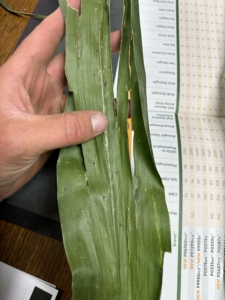
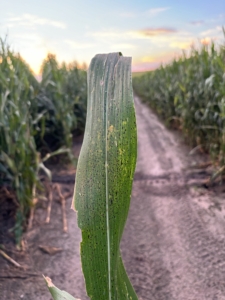
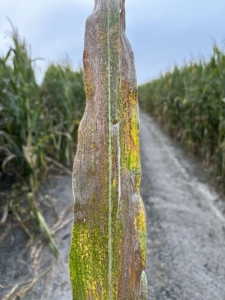
- First photo is from August 15th, first lesions. Second photo is two weeks later, August 29th and third photo is another week later, September 4th. This disease bears watching in the years ahead. This is on a hailed field, so progression is faster than normal.
- This second set of photos is a comparison of a split planter of P1413AM vs. 112 day competitor, on tar spot and southern rust levels. Photos taken September 10th. This set of photos is from a field that had a fungicide applied.
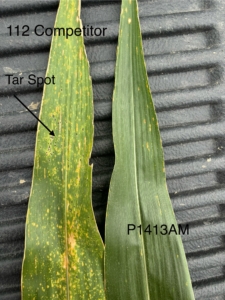
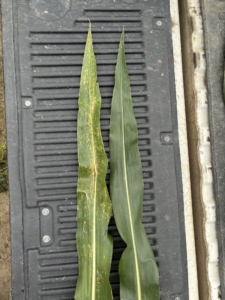
- For Tar Spot, Pioneer offers some of the leading tolerance, across the hybrid lineup, within the seed industry. Besides the irrigated acre, keep this in mind for the dryland and more marginal acres, that do not see a fungicide every year…
- Due to the higher incidence of disease pressure in 2024, we expect to see an impact on area corn acres this year, most likely in late-season plant health. See Prioritizing Harvest below for more info.
- Because of the delayed growing season, it is somewhat early to determine overall grain quality heading into harvest. Test weights are still being determined over the next couple of weeks.
- Irrigation demand is slowing down and we can see the end, but is still needed in many cases. Keep in mind that 1/2 milk line corn requires 2.5″ – 3″ to finish, more in hot weather. ET rates will approach .30-.40+ over next few days if humidity stays low and winds increase. Keep this in mind over the next 5-7 days. Don’t shutoff to early….the longer it stays green, the better yield and plant health.
Current Soybean Conditions…..
- Soybeans are starting to turn in much of the area. Most fields are in mid-R6 to early R7. The early group II soybeans are moving along quickly now. A few mid-April planting dates with 2.0 maturity could be ready to harvest by next week, if heat comes as forecasted.
- Disease: Sudden Death Syndrome (SDS) is present in the area, but not at the levels it was seen last year. The same can be said for White Mold infestations. White Mold has been light, compared to last year. Disease pressure in soybeans has been much reduced this year compared to prior few years.
- Irrigation: Fields in the late-R6 to early-R7 stage need approximately 1.5-3″ of moisture to finish. For reference, the chart below shows soybean stage of growth at R6-R7. Don’t give up on that last watering…..
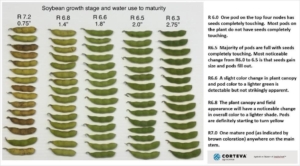
- Dectes Stem Borer. This insect enters the plant at a node and proceeds to ‘hollow out’ the stem leading to early plant death. So far not much one can do in the way of management for this insect yet. However, we are expecting to see heavier levels of this insect in our area versus the past few years. Keep this in mind as harvest begins and progresses. For more info see the following link….Dectes Stem Borer in Soybeans
Prioritizing Harvest!
The extremes in weather (early planting conditions/rainfall, cool summer with intermittent heat spells, reduced sunlight during grain fill, increased disease pressure, drought conditions) in 2024 have the potential to impact late-season stalk quality. Southern Rust will have the biggest impact on stalk quality, which was the case in 2006. Heavy fields of Southern Rust will be very likely to have poor late-season stalk quality. We are also seeing Crown Rot show up in area fields. Infestation is variable across the area, but it is noticeable. See photo for ‘ghost stalk’…..
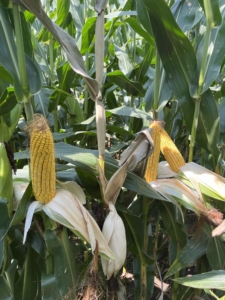
Stalk rots appear each year with varying degrees of severity. They are caused primarily by fungi and bacteria, but they can also result from environmental stresses. When these diseases or conditions happen, they weaken or destroy vascular tissue in the stalk, and the plant cannot transport water or carbohydrates effectively, which ultimately results in premature plant death and reduced grain fill. The environmental stresses this year are putting more pressure on plant health. Watch for those fields that lose staygreen quickly, or that have ears droop suddenly, as these are signs of premature plant death. The longer the plant stays green, the better the standability will be as harvest progresses. Bottom line….we are expecting 2024 harvest to have significantly more issues with stalk integrity as harvest progresses. This is one year where you want to be ready ‘to go’ at the first opportunity….equipment, labor, etc.
New Corn Hybrids and Soybean Series
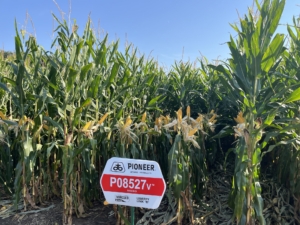
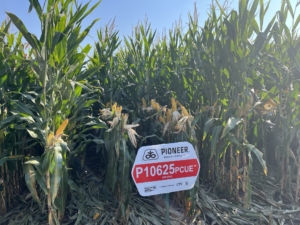
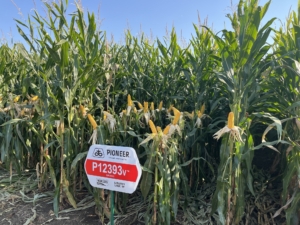
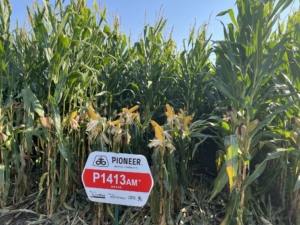
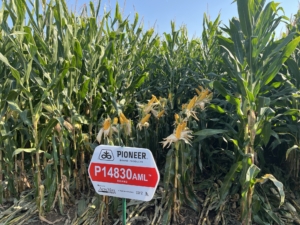
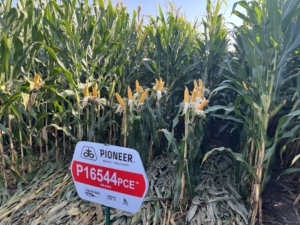
The above photos are some of the new hybrids for 2025 with a couple of the leader products from the show plot. For 2025, Pioneer has over seven new corn hybrids across the 105-116 day maturities. The photos above show some of these new products. For 2025, Pioneer is also introducing new Powercore Enlist, Powercore Ultra Enlist and Vorceed Enlist technology in corn. All new hybrids from Pioneer in 2025 will have the Enlist technology, with Powercore providing above ground protection like the current AM products, Powercore Ultra providing above ground protection like the current AML products, and Vorceed is the new corn rootworm protection with RNAi performance. These hybrids offer excellent drought tolerance (one new AquaMax hybrid) as well as good disease tolerance such as Goss’s Wilt and Grey Leaf Spot, with very good staygreen and improved brittle and root scores. These are some numbers to watch as harvest progresses.
Pioneer has launched a new series of Enlist beans this year – the ‘Z-Series’ soybeans. ‘Z-Series’ is the next generation in soybean breeding, bringing an increase in yield with improved, industry-leading, agronomic and disease scores. Watch for Z-Series soybeans as harvest moves forward!
Just FYI, a quick update on Dicamba for over-the-top on soybeans. As it sits today, there is no label for over-the-top application of Dicamba on soybeans for the 2025 growing season. Dicamba is under review for renewed labeling under the FIFRA law with the EPA. What label, if any, may come out by next spring is anybody’s guess at this time. Bayer’s new proposed label to the EPA is for a pre-emerge only.
Please let us know any questions or concerns or comments you may have. Let us know how we can help as harvest gets going! Thanks for your support!
Starman Seed & Supply, Inc.
